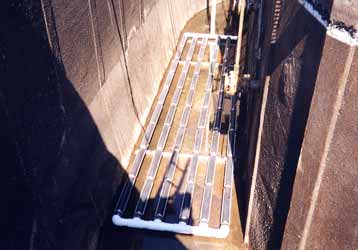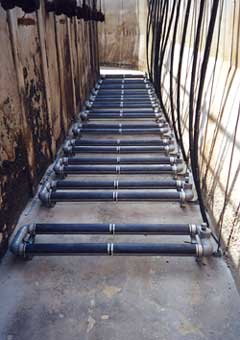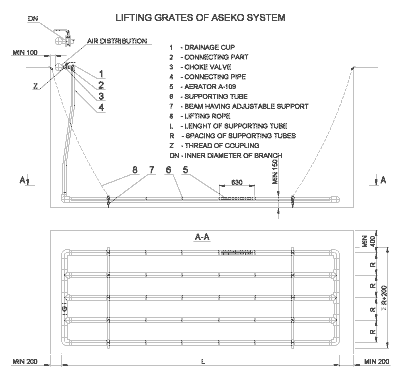Supporting tubes (6)
with aerators (5)
are connected with each other into a grate with a common air supply system.
Supporting tubes with aerators are balanced against buoyant force in water
with the help of internal load. They are placed on two beams having adjustable
screws (7),
which abut on the bottom of the tank without further anchorage.

Air distribution system, at the air inlet into the grate, is provided either with a coupling with external pipe thread or by a T-joint with flange connection. Air is supplied to each grate through a choke valve (3) connecting part (2) and connecting pipe (4). The connecting pipe can be either flexible or fixed. The choke valve and the connecting part serve to shut off air supply and disconnect the pipe (4) when the lifting grate is removed from the tank. The choke valves further enables to shut off air supply to individual grates, when it is out of operation, while the rest part of aerating system continues in operation.

Removal of the grate and its reassembling into the tank is made by means
of lifting ropes (8).
Each grate is equipped with a mechanism to drain condensed water from
the air. From the drainage cap (1),
a small pipe is led through the internal part of the connection pipe (4)
to the bottom of the internal grate.
After opening of drainage cap and with the system operating fully , internal
air overpressure discharges the condensed water from the grate above the
water level.
Lifting grates are intended for tanks accessible by a hoisting mechanism (crane) and for tanks where it is advantageous to introduce a common air supply to supporting pipes with aerators.

The lifting grates enable, if required, installation
into filled activation tanks. Removal and reassembling of individual supporting
tubes for the purposes of checking or repair can be performed under full
operation without stopping the work or interruption of pumping.
Removal is performed by means of a hoisting mechanism (crane). The lifting
grates are levelled with adjusting screws on the beams. In this way, the
bottom of the tank is made even and any possible surface irregularity
is eliminated.
The aerating system, built from many independent grates with aerators,
enables easy regulation of oxygen transfer in individual parts of activation.
